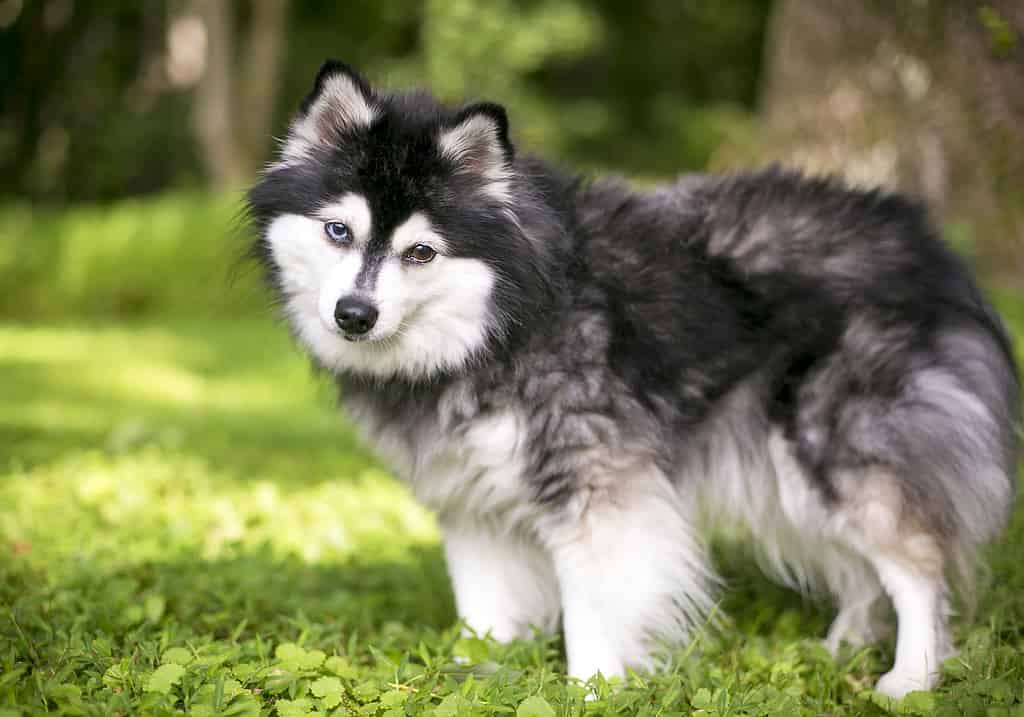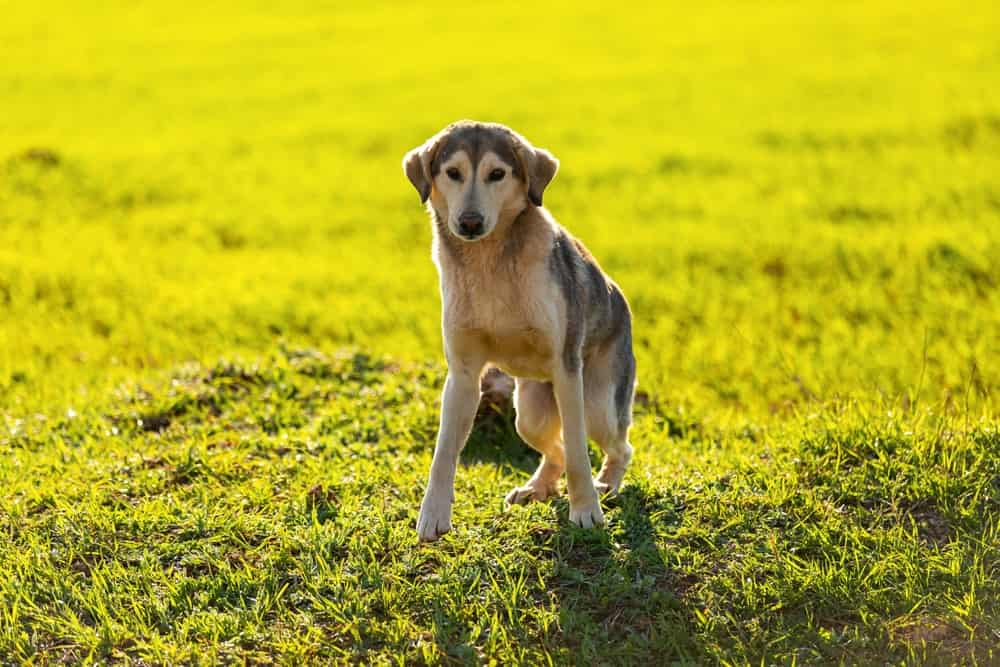There are many rare genetic mutations that your pets can have, and all of them are a little different from one another. Some genetic mutations found in pets are cute, and rather harmless, while others can have some unhealthy side effects.
Learn more about some of the rare, but still common enough to possibly occur with your next animal, genetic mutations. You’ll learn more about what they’ll look like on animals and some of the health issues and genetic changes that cause them.
1. Vitiligo

Vitiligo is a rare condition in both people and pets.
©JelenaBekvalac/Shutterstock.com
When you first hear about vitiligo, you may think of people. While people certainly get this condition, it’s not just humans. Pets, like cats and dogs, also get this condition. For those who don’t know, vitiligo is a condition that causes the depigmentation of skin.
An animal with vitiligo will start to lose their previous coloring. This may be in small specks or big patches on the body or the face. Usually, the skin and hair will turn white. Sometimes, the skin may turn a light pink as well.
Some breeds are more predisposed than others, but it can happen in any breed. German shepherds, rottweilers, German shorthaired pointers, and Doberman pinschers are the most common breeds of dogs. Siamese cats may also be predisposed. Thankfully, it’s a painless process that doesn’t hurt your pet at all.
The cause of vitiligo isn’t exactly clear. It’s thought to be a mix of a genetic mutation and possibly outside factors. Stress, UV light, and chemicals have all been suggested as a possibility. As for the genetic side, it appears to be due to mutations in the AIRE 1 gene.
2. Polydactyly
Polydactyly is a rare case in pets where they have extra toes. There are a few different kinds. Postaxial is when the extra toes are on the outside of the paw. Then, there is the preaxial, which is on the inside of the toe. The final kind is mesoaxial, which occurs throughout the paw and looks like a combination of the first two options.
For the most part, this genetic mutation is harmless. Most often, the biggest issues are that it’s a little extra difficult to clip your pet’s claws and it may catch on furniture more.
Some dogs are bred to have extra toes, such as the Norweigan lundehund. All the toes are fully formed. It’s thought that the extra toes are helpful with the snow and uneven ground. However, for most pets, it’s an autosomal recessive genetic mutation.
3. Trisomy
Trisomy is a condition that creates additional chromosomes. In people, the most common forms of trisomy are Down syndrome, Edward syndrome, and Patau syndrome.
While animals can’t technically have these syndromes as they don’t have the right number of chromosomes, they can have their own form of trisomy. The symptoms are often the same; including facial abnormalities, smaller-sized bodies than normal, and also cognitive impairments.
Like with people, the animals often need a little extra help and care. They can have issues with motor function, hearing, vision, muscles, and heart problems. With the right care, these animals can live a long and happy life, but it does take a little extra work.
4. Heterochromia

Some breeds, like huskies, have a good chance of developing heterochromia.
©Mary Swift/iStock via Getty Images
There are a couple of types of heterochromia. The first is complete heterochromia. This is the most common kind, where each eye is a different color. Then, there is central heterochromia. This is when the eyes have two colors. usually, there is one color around the pupil and another on the outside of the iris.
The final kind is sectoral heterochromia. This is where one eye is split into two colors, usually each taking up roughly half the eye. This form often only occurs in one eye, but it can occur in two eyes. Sometimes, animals and people can have multiple forms of heterochromia.
In pets, heterochromia is more often hereditary. This is why huskies are often seen with it. The condition gets passed down through the parents. This is one of the more common animal genetic mutations. It’s more common in cats and dogs than people, as it can be passed down from parent to child.
5. Folded Ears

Scottish fold cats are the breed most known for having floppy ears.
©Ozge Emir/iStock via Getty Images
There’s not much cuter than the Scottish fold cats with their floppy ears. It makes them look sad and curious. However, it’s due to a genetic mutation that their ears have this appearance. The genetic mutation inhibits the development of cartilage.
This means it’s not just the ears affected. However, the ears are the most obvious change. This may make many believe that it’s a rather harmless mutation, but that’s not the case. Unfortunately, all cartilage in the body is affected. The genetic mutation also affects the cartilage in the bones, which leads to a rather painful arthritis. These abnormalities are known as osteochondroplasia.
6. Dwarfism
Like people, dogs and cats can have dwarfism. The most obvious sign is that they are usually smaller, but there are other symptoms as well, including bulging eyes and short legs.
There are a few different kinds of dwarfism. Each one affects the animals a little differently. The first is achondroplasia. This is a condition also found in people. The mutations are inherited in dogs. This is what leads to corgis and dachshunds having long bodies but rather short legs.
Then there is pituitary dwarfism, also known as juvenile-onset panhypopituitarism. This is a more serious issue. It occurs when the pituitary gland fails to develop properly, sometimes due to a tumor. It happens during the fetal growth. Because it inhibits the growth hormone, other hormone deficiencies are common.
Other genetic disorders often come along with dwarfism. Brachycephalic syndrome, where the dog’s face is smushed up and they have difficulty breathing, often comes along with some forms of dwarfism. Spinal issues and enlarged joints are also often regularly seen.
The breeds most prone to achondroplasia dwarfism include bulldogs, basset hounds, pugs, and Pekingese. For pituitary dwarfism, German shepherds are the most common, but miniature pinschers have also been reported to have this trait.
7. Four Ears
Have you ever seen a cat with four ears? You may be surprised to find that it’s a somewhat common genetic disorder in cats. It’s rather rare, to the point where most people haven’t seen a cat with four ears. However, it’s also common enough that scientists have done some research on it.
The cats, though it looks a lot like four ears, don’t have multiple ears. Instead, what happens is that the outer ear flaps grow much larger than they normally would.
The condition is rare and recessive. Both of the cat’s parents need to have the genetic mutation for the trait to show up in the cat.
Though it looks like the cat has four ears, the skin flaps don’t earn any extra benefits. They don’t provide extra hearing skills. It’s actually thought that the extra flap may act as a handicap. However, it doesn’t seem to affect the hearing. Instead, it should be connected to other genetic mutations that cause deformities
While cats are the most common animals to get this disorder, they aren’t the only ones. Rabbits have also been found to get a second set of ears.
8. Short Spine Syndrome

Many of the dogs with short spine syndrome are famous across the internet.
©Ali _Cobanoglu/Shutterstock.com
Short Spine Syndrome is very rare. It’s estimated that only 30 dogs in the world have it. Because of its rarity, there’s not much known about it. However, it is thought that part of the problem is severe inbreeding.
Short Spine Syndrome is when most of the spine remains more like cartilage and softer than proper bone. Some of the vertebrae also fuse, which compresses and shortens the spine. It also restricts movement.
Often, the compression happens around the neck. This makes the dog appear to have no neck. It also limits their neck movement. These dogs aren’t able to turn their heads to look behind them.
However, this hasn’t stopped these dogs from enjoying life. The ones that are active on social media all appear quite happy and relatively unaffected by the condition.
9. Gigantism

Having a dog breed that’s meant to be large is different from the dogs that have gigantism.
©Kaca Skokanova/Shutterstock.com
Some animals can show signs of gigantism. There are a few different names for it in animals, such as acromegaly and hypersomatotropism.
They are often endocrine disorders. The disorder sets up the pituitary gland and pushes it to overproduce the somatotropin or growth hormone. The two disorders are a little different. Acromegaly is the overproduction of tissue, while hypersomatotropism is the overproduction of the growth hormone.
Sometimes, tumors in the pituitary gland can cause gigantism. While it’s cute to have a giant puppy and an abnormally large dog, it’s not all perfect. Studies have shown that animals with acromegaly tend to live a shorter life on average than other dogs of the same breed.
On average, the life expectancy for a dog with acromegaly is six to seven years old. Though, with the proper treatment, the dogs may live a little longer.
10. Megaesophagus

High chairs are often for babies but they can work for dogs too in unique circumstances.
©Ekaterina_Kuzmina/Shutterstock.com
Have you ever seen videos of dogs that have their own special high chairs to eat? These cute little dog seats started because of a dog with a megaesophagus.
Technically, megaesophagus isn’t just one single disorder or disease. It’s a mix of problems. Usually, the esophagus has become larger and loses the ability to move food from the throat to the stomach.
The problem is that these dogs aren’t able to eat like normal. There’s no signal to their brain that they need to swallow. It’s common for these dogs to regurgitate because food and water sit inside the esophagus and come back up.
Regurgitation is a little different from vomiting. They don’t gag, retch, or get nauseous before they throw up. In regurgitation, the food just comes right back up.
Having the dog sit up and eat helps the food go down all the way to the stomach so it’s not sitting in the esophagus.
It’s not just dogs that have this problem. However, dogs are the most common animal to get this series of mutations. Some dog breeds are genetically predisposed to have a megaesophagus. These are:
The photo featured at the top of this post is © Linalyan/Shutterstock.com
Thank you for reading! Have some feedback for us? Contact the AZ Animals editorial team.






